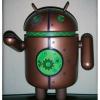I wanted to make this thread for all our new users and everyone new to android. Please read as much as you can and take it all in. This is a great thread for learning most of your basic Android stuff. If you still have any questions, please feel free to ask! Also, please feel free to make any suggestions for content to add to this. Now without further ado:
Android Terms & Definitions
Apps2SD: A method of storing applications and cache on the device's microSD card.
ADB: Android Debug Bridge (adb) is a versatile command line tool that lets you communicate with an emulator instance or connected Android-powered device. It is a client-server program that includes three components:
• A client, which runs on your development machine. You can invoke a client from a shell by issuing an adb command. Other Android tools such as the ADT plugin and DDMS also create adb clients.
• A server, which runs as a background process on your development machine. The server manages communication between the client and the adb daemon running on an emulator or device.
• A daemon, which runs as a background process on each emulator or device instance.
Android: A Linux-based operating system for mobile devices such as HTC EVO.Versions are alphabetically codenamed after snacks: Donut, Eclair, Froyo, Gingerbread, Honeycomb, Ice Cream Sandwich, Jelly Bean.
AMOLED: Active Matrix Organic Light Emitting Diode. Basically, a very colorful, bright, display found in some smartphones.
APK: Android application package file. Each Android application is compiled and packaged in a single file that includes all of the application's code (.dex files), resources, assets, and manifest file. The application package file can have any name but must use the .apk extension. For example: myExampleAppname.apk. For convenience, an application package file is often referred to as an ".apk".
Alpha: The alpha phase of the release life cycle is the first phase to begin software testing (alpha is the first letter of the Greek alphabet, used as the number 1). In this phase, developers generally test the software using white box techniques. Additional validation is then performed using black box or gray box techniques, by another testing team. Moving to black box testing inside the organization is known as alpha release.[1]
Alpha software can be unstable and could cause crashes or data loss. The exception to this is when the alpha is available publicly (such as a pre-order bonus), in which developers normally push for stability so that their testers can test properly. External availability of alpha software is uncommon in proprietary software. However, open source software, in particular, often have publicly available alpha versions, often distributed as the raw source code of the software.
The alpha phase usually ends with a feature freeze, indicating that no more features will be added to the software. At this time, the software is said to be a feature complete.
Boot Animation: Boot animation is a term for a graphical representation of the boot process of the operating system.
Boot animation can be a simple visualisation of the scrolling boot messages in the console, but it can also present graphics or some combinations of both.
Unlike Splash Screens (boot logos), boot screen or boot animation is not necessarily designed for marketing purposes, but can be to enhance the experience of the user as eye candy, or provide the user with messages (with an added advantage of color coding facility) to diagnose the state of the system.
Bootloader: This small program's only job is to load other data and programs which are then executed from RAM. Often, multiple-stage boot loaders are used, during which several programs of increasing complexity load one after the other in a process of chain loading.
Bootloop: When your system recycles over and over without entering the main OS.
Beta: Is the software development phase following alpha. It generally begins when the software is feature complete. Software in the beta phase will generally have many more bugs in it than completed software, as well as speed/performance issues. The focus of beta testing is reducing impacts to users, often incorporating usability testing. The process of delivering a beta version to the users is called beta release and this is typically the first time that the software is available outside of the organization that developed it.
The users of a beta version are called beta testers. They are usually customers or prospective customers of the organization that develops the software, willing to test the software without charge, often receiving the final software free of charge or for a reduced price.
Beta version software is often useful for demonstrations and previews within an organization and to prospective customers. Some developers refer to this stage as a preview, prototype, technical preview (TP), or early access.
Some software is kept in perpetual beta—where new features and functionality is continually added to the software without establishing a firm "final" release.
CPU: It stands for Central Processing Unit and handles all the complex mathematical formulas necessary to do everyday things like surfing the Internet.
Custom: Independent developers who like to customize their devices beyond the standard options provided often tend to release the fruits of their labor for the rest to enjoy, in form of custom ROMs.
Cache: A component that transparently stores data so that future requests for that data can be served faster. The data that is stored within a cache might be values that have been computed earlier or duplicates of original values that are stored elsewhere. If requested data is contained in the cache (cache hit), this request can be served by simply reading the cache, which is comparatively faster. Otherwise (cache miss), the data has to be recomputed or fetched from its original storage location, which is comparatively slower. Hence, the greater the number of requests that can be served from the cache, the faster the overall system performance becomes.
CDMA: Mobile phone standards called cdmaOne, CDMA2000 (the 3G evolution of cdmaOne) and WCDMA (the 3G standard used by GSM carriers), which are often referred to as simply CDMA, and use CDMA as an underlying channel access method.
CIQ: Carrier IQ. A piece of preinstalled software that runs with elevated access in the background of portable devices by default and records everything. Potentially can be exploited to steal information.
Dual Core: A dual core processor is a central processing unit (CPU) that has two separate cores on the same die, each with its own cache. It essentially is two microprocessors in one. This type of CPU is widely available from many manufacturers. Other types of multi-core processors also have been developed, including quad-core processors with four cores each, hexa-core processors with six, octa-core processors with eight and many-core processors with an even larger number of cores.
Dalvik: The Android platform's virtual machine. The Dalvik VM is an interpreter-only virtual machine that executes files in the Dalvik Executable (.dex) format, a format that is optimized for efficient storage and memory-mappable execution.
Dalvik Cache: Writable cache that contains the optimized bytecode of all apk files (apps) on your Android device. Having the information in it's own cache makes applications load faster and perform better.
EXT.(Extended File System): The extended file system, or ext, was implemented in 1992 as the first file system created specifically for the Linux kernel. It has metadata structure inspired by the traditional Unix File System and was designed by Rémy Card. It was the first implementation that used the virtual file system and it could handle file systems up to 2 gigabytes in size.
The ext2, ext3 and ext4 file systems were all derived from this one. Most ext discussions center around ext3 and ext4 in the Android world.
ext3 is a journaled file system that is commonly used by the Linux kernel. Its main advantage over ext2 is journaling, which improves reliability and eliminates the need to check the file system after an unclean shutdown. Generally, ext3 is slower than competing Linux filesystems, such as ext4, JFS, ReiserFS and XFS, but it has a significant advantage in that it allows in-place upgrades from ext2 without having to back up and restore data. Benchmarks suggest that ext3 also uses less CPU power than ReiserFS and XFS. It is also considered safer than the other Linux file systems, due to its relative simplicity and wider testing base. ext3 does not do checksumming when writing to the journal and if the hardware is doing out-of-order write caching, you run the risk of severe filesystem corruption during a crash.
ext4 was created as a series of backward compatible extensions to ext3. In January 2010, Google announced that it would upgrade its storage infrastructure from ext2 to ext4. In December 2010, they also announced they would use ext4, instead of YAFFS, on Android. The ext4 advantages include large file system support, extents, persistent pre-allocation and journal checksumming.
FC/FC's: Short for "force close," meaning an app that has crashed.
Fastboot: A diagnostic protocol used primarily to modify the flash filesystem in Android smartphones from another computer over a USB connection. It is part of the Android Debug Bridge library.
Utilizing the Fastboot protocol requires that the device be started in a boot loader or Second Program Loader mode in which only the most basic hardware initialization is performed. After enabling the protocol on the device itself it will accept any command sent to it over USB via a command line. Some of most commonly used fastboot commands include:
•flash - Overwrites a partition in flash with a binary image stored on the host computer.
•erase - Erases a partition in flash.
•reboot - Reboots the device into the either the main operating system or the system recovery partition.
•devices - Displays a list of all devices (with Serial #) connected to the host computer.
Flash Memory: The ROM memory used in smartphones and tablets etc. is often same as flash memory found in SD cards and USB flash drives, simply optimized for better speed and performance while running the operating system.
Hotspot: A spot that offers Internet access over a wireless local area network through the use of a router connected to a link to an Internet service provider. Hotspots typically use Wi-Fi technology.You can connect wifi campatible devices to it.
HDMI: High-Definition Multimedia Interface) is a compact audio/video interface for transmitting encrypted uncompressed digital data.It is a digital alternative to consumer analog standards, such as radio frequency (RF) coaxial cable, composite video, S-Video, SCART, component video, D-Terminal, or VGA (also called D-sub or DE-15F). HDMI connects digital audio/video sources (such as set-top boxes, DVD players, HD DVD players, Blu-ray Disc players, AVCHD camcorders, personal computers (PCs), video game consoles (such as the PlayStation 3 and Xbox 360), AV receivers, tablet computers, and mobile phones) to compatible digital audio devices, computer monitors, video projectors, and digital televisions.
Hboot: It’s mainly responsible for checking and initializing the hardware and starting the phone’s software. It can also be used for flashing official software releases, as well as a few other things. HBoot can be compared to the BIOS on a computer. While a normal "bootloader" is found on most Motorola devices, HBoot is typically found on HTC devices.
HAVS: A control system that dynamically adjusts the voltage based on CPU load. This has proven to be a battery saver, but it can actually have the opposite effect when multiple control systems are operating (like setCPU).
JIT: The Just-in-Time Compiler. Released with Android 2.2, it's a method of greatly speeding up apps in Android on the software side.
Kernel: A kernel is a layer of code that allows the OS and applications to interface with your phone's hardware. The degree in which you can access your phone's hardware features depends on the quality of code in the kernel. The homebrew (rooting) community for HTC has made several kernel code improvements that give us additional features from our hardware that the stock kernel does not. When you flash a custom ROM, you automatically get a kernel. But you can also flash a standalone kernel ROM on top of the existing one, effectively overwriting it. These days, the difference in custom kernels is less about new features and more about alternate configurations. Choosing a custom kernel is basically choosing one that works best with your ROM.
Launcher: Collectively, the part of the Android user interface on home screens that lets you launch apps, make phone calls, etc. Is built in to Android, or can be purchased in the Android Market.
LCD Density: Pixel density is a measurement of the resolution of devices in various contexts; typically computer displays, image scanners, and digital camera image sensors.
First of all you need to understand that the Android User Interface uses something called a "display independent pixel" or a "dip" (yes, it's confusing because the density settings are in "dots per inch" or "dpi" which are considered the same as "ppi" or "pixels per inch" as well).
The default LCD Density setting on AOSP is 160 dpi. As far as the operating system is concerned 1 dip @ 160 dpi = 1 screen pixel. It doesn't mean that's actually true, but you've gotta start somewhere. In my opinion it would have been a lot nicer if they'd chosen 100 dpi because then it would be an easy percentage thing, but they didn't so we're stuck with this formula.
Mod: The act of modifying a piece of hardware or software or anything else for that matter, to perform a function not originally conceived or intended by the designer.
NILFS: (New Implementation of a Log-structured File System) is a log-structured file system for Linux. It is being developed by Nippon Telegraph and Telephone Corporation (NTT) CyberSpace Laboratories. It uses a copy-on-write technique known as "nothing in life is free", NILFS records all data in a continuous log-like format that is only appended to, never overwritten, a design intended to reduce seek times, as well as minimize the kind of data loss that occurs after a crash with conventional file systems. For example, data loss occurs on ext3 file systems when the system crashes during a write operation. When the system reboots, the journal notes that the write did not complete, and any partial data writes are lost. NILFS also includes fast write and recovery times, minimal damage to file data and system consistency on hardware failure, 32-bit checksums, etc.
Android kernels do not routinely include NILFS although mods to make it available can be found.
Nandroid: Nandroid is used to backup or restore backups from Recovery. You can chose to either do a regular backup (Phone only) or a backup + sd-ext (Phone + Apps2sd ext.)Both will backup your whole system, the second will include apps saved on your sdcard’s sd-ext.
Nightly: A build that is performed at the end of each day of development. If you use a continuous integration server, it will generally be configured to build the code and run the unit tests on every check in. At the end of each day you may want to run more extensive tests, regression test and integration tests for example, which take too long to run on each check in and these would be triggered after the nightly build. If you have a full continuously delivery pipeline the nightly build may also be used to deploy the built code to environments for user testing.
OpenGL ES: Android provides OpenGL ES libraries that you can use for fast, complex 3D images. It is harder to use than a Canvas object, but better for 3D objects. The android.opengl and javax.microedition.khronos.opengles packages expose OpenGL ES functionality.
Open & Closed Beta: Developers release either a closed beta or an open beta; closed beta versions are released to a select group of individuals for a user test and are invitation only, while open betas are from a larger group to the general public and anyone interested. The testers report any bugs that they find, and sometimes suggest additional features they think should be available in the final version.
Overclock: To increase the speed of your CPU beyond the factory settings.
Partition: The phone's internal memory (not the SD card) is solid-state (flash) memory, AKA NAND. It can be partitioned much like a normal hard drive can be partitioned. The bootloader exists in its own partition. Recovery is another partition; radio, system, cache, etc are all partitions.
Here are the standard partitions on an Android phone:
/boot - bootloader, kernel
/recovery - holds the recovery program (either clockworkmod or TWRP)
/system - operating system goes here: Android, boot animation, Verizon crapware, busybox, etc
/cache - cached data from OS usage
/data - user applications, data, settings, etc.
The below partitions are not android-specific. They are tied to the hardware of the phone, but the kernel may have code allowing Android to interact with said hardware.
/radio - the phone's radio firmware, controls cellular, data, GPS, bluetooth.
/wimax - firmware for Sprint's flavor of 4G, WiMax.
PRL: The Preferred Roaming List, basically a way of telling your phone which towers to connect to first.
Recovery: The recovery partition is a boot-mode for your phone that allows you to wipe your settings from the Data partition of the phone (a hard wipe), or perform an update using an update.zip file on the root of the microSD card. It is common (although not necessary) to flash a patched Recovery image, such as TWRP or ClockworkMod Recovery. This allows you to run Nandroid backup from the device, and flash modifications, such as files to the device, essentially becoming a means to install software to the device. Recovery mode is separate from ‘normal’ mode, and can be entered by holding down home whilst turning the phone on.
Rom/Firmware: Read-Only Memory and technically speaking, it refers to the internal storage of a device, which is supposed to contain the operating system instructions that doesn't need to be modified at all during the device’s normal operation.
Radios: Typically the radios persist of:
•WiFi, which operates at 2.4-5ghz depending on what channel it's running
•Cellular/3G, which carries voice and data
•4G/WiMAX, which only carries data
•GPS, which is receive-only
•Bluetooth, which talks to WiiMotes and headsets
Flashing a radio means updating the code that controls the phones way of sending and recieving a signal.
Ram: (Random Access Memory) A group of memory chips, typically of the dynamic RAM (DRAM) type, which function as the computer's primary workspace. When personal computers first came on the market in the late 1970s, 64KB (64 kilobytes) of RAM was the upper limit. Today, 64MB (64 megabytes) of SDRAM is entry level for a desktop computer, a thousand times as much (see SDRAM).
The "random" in RAM means that the contents of each byte of storage in the chip can be directly accessed without regard to the bytes before or after it. This is also true of other types of memory chips, including ROMs and PROMs. However, unlike ROMs and PROMs, RAM chips require power to maintain their content, which is why you must save your data onto disk before you turn the computer off. To learn about the types of RAM chips and how to upgrade your memory, see memory module. To learn how memory is used to process data, see computer or memory. See also dynamic RAM and static RAM.
Root: The first level of a folder.
Rooting: A process allowing users of mobile phones, tablet PCs, and other devices running the Android operating system to attain privileged control (known as "root access") within Android's subsystem. Rooting is often performed with the goal of overcoming limitations that carriers and hardware manufacturers put on some devices, resulting in the ability to alter or replace system applications and settings, run specialized apps that require administrator-level permissions, or perform other operations that are otherwise inaccessible to a normal Android user. Rooting is analogous to jailbreaking devices running the Apple iOS operating system or the Sony PlayStation 3. On Android, rooting can also facilitate the complete removal and replacement of the device's operating system.
Sideloading: It means installing applications without using the official Android Market.
Splash Screen: A splash screen is an image that appears while android is loading.Splash screens cover the entire screen or simply a rectangle near the center of the screen. The splash screens of operating systems and some applications that expect to be run full-screen usually cover the entire screen.
Superuser/SU: On many computer operating systems, the superuser is a special user account used for system administration. Depending on the operating system, the actual name of this account might be: root, administrator or supervisor.
Normal work on such a system is done using ordinary user accounts, and because these do not have the ability to make system-wide changes any viruses and other malware - or simple user errors - do not have the ability to adversly affect a whole system. In organizations, administrative privileges are often reserved for authorized experienced individuals.
Script: The Scripting Layer for Android (abridged as SL4A, and previously named Android Scripting Environment or ASE) is a library that allows the creation and running of scripts written in various scripting languages directly on Android devices. SL4A is designed for developers and is still alpha quality software.
These scripts have access to many of the APIs available to normal Java Android applications, but with a simplified interface. Scripts can be run interactively in a terminal, in the background, or via Locale.
SDK: (SDK or "devkit") is typically a set of software development tools that allows for the creation of applications for a certain software package, software framework, hardware platform, computer system, video game console, operating system, or similar platform.
Stock: This is the operating system in its default form, without any modifications made to it except for any device-specific support required to run it on the particular device.
Tethering: Means sharing the Internet connection of an Internet-capable mobile phone with other devices. This sharing can be offered over a wireless LAN (Wi-Fi), Bluetooth, or by physical connection using a cable. In the case of tethering over wireless LAN, the feature may be branded as a mobile hotspot.The Internet-connected mobile phone acts as a portable router when providing tethering services to others.
Underclock: To reduce the speed of your CPU below the factory settings.
Undervolt: Undervolting means taking some of the voltage from the CPU which in return gives a longer battery life and lower temperature during intensive use of the CPU.
USB: Stands for Universal Serial Bus. Is a method of connecting devices to a computer. Most smartphones now use microUSB cables to charge and sync.
Updater Script: When Android devices install updates via 'update.zip' files using recovery mode they have to perform a wide range of functions on files and permissions. Instead of using a minimal shell such as {b,d,c}sh the Android designers decided to create a small functional language that can be extended by device manufacturers if necessary. Since the Android "Donut" release (v1.6) the scripting language is called Edify and is defined primarily in the bootable/recovery/{edify,edifyscripting,updater} directories of the Android source-code tree.
Zipalign: An archive alignment tool introduced first time with 1.6 Android SDK (software development kit). It optimizes the way an Android application package (APK) is packaged. Doing so enables the Android operating system to interact with the application more efficiently, and hence has the potential to make the application and overall the whole system much faster. Execution time is minimized for zipaligned applications, resulting is lesser amount of RAM consumption when running the APK.






























